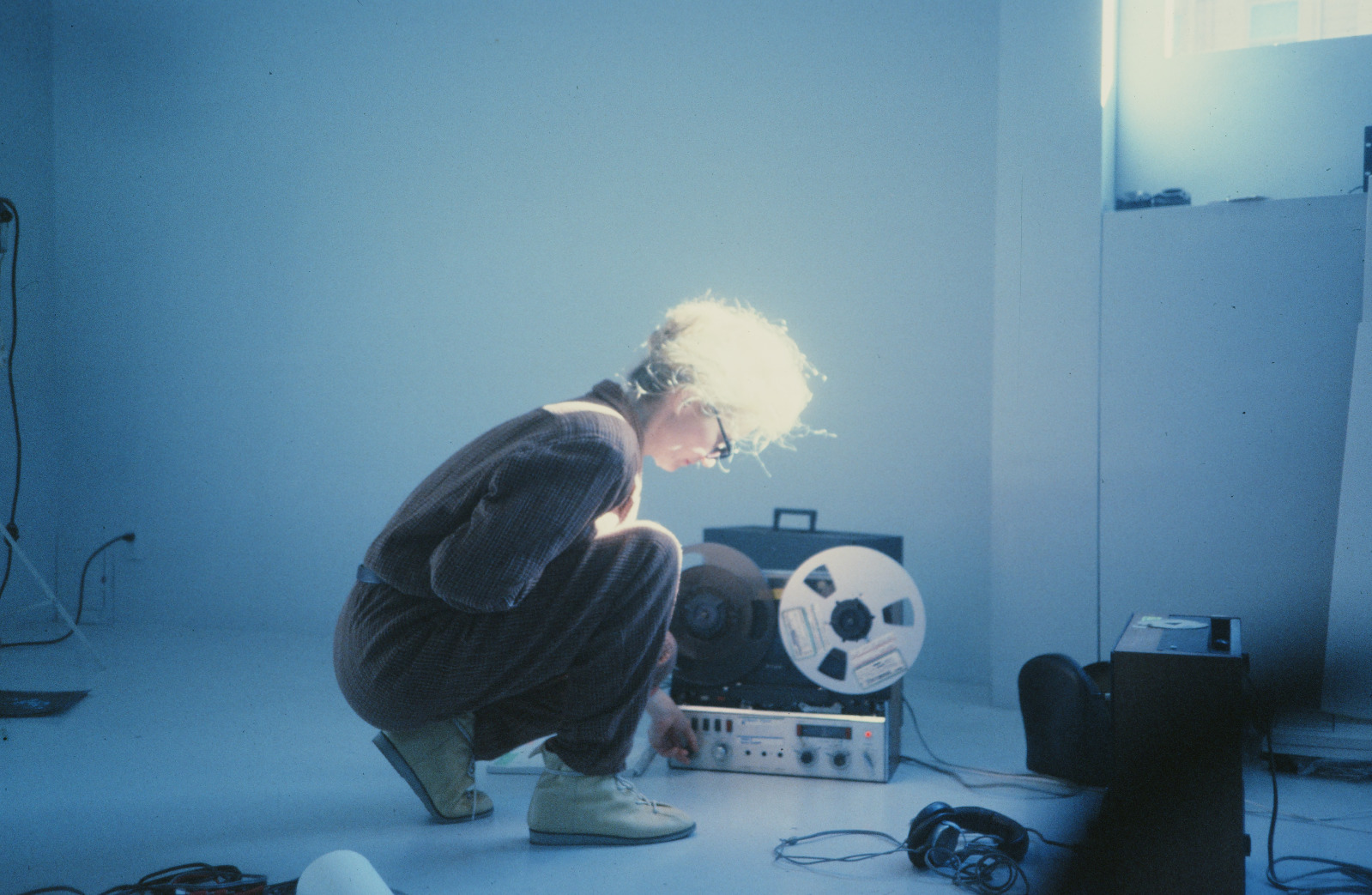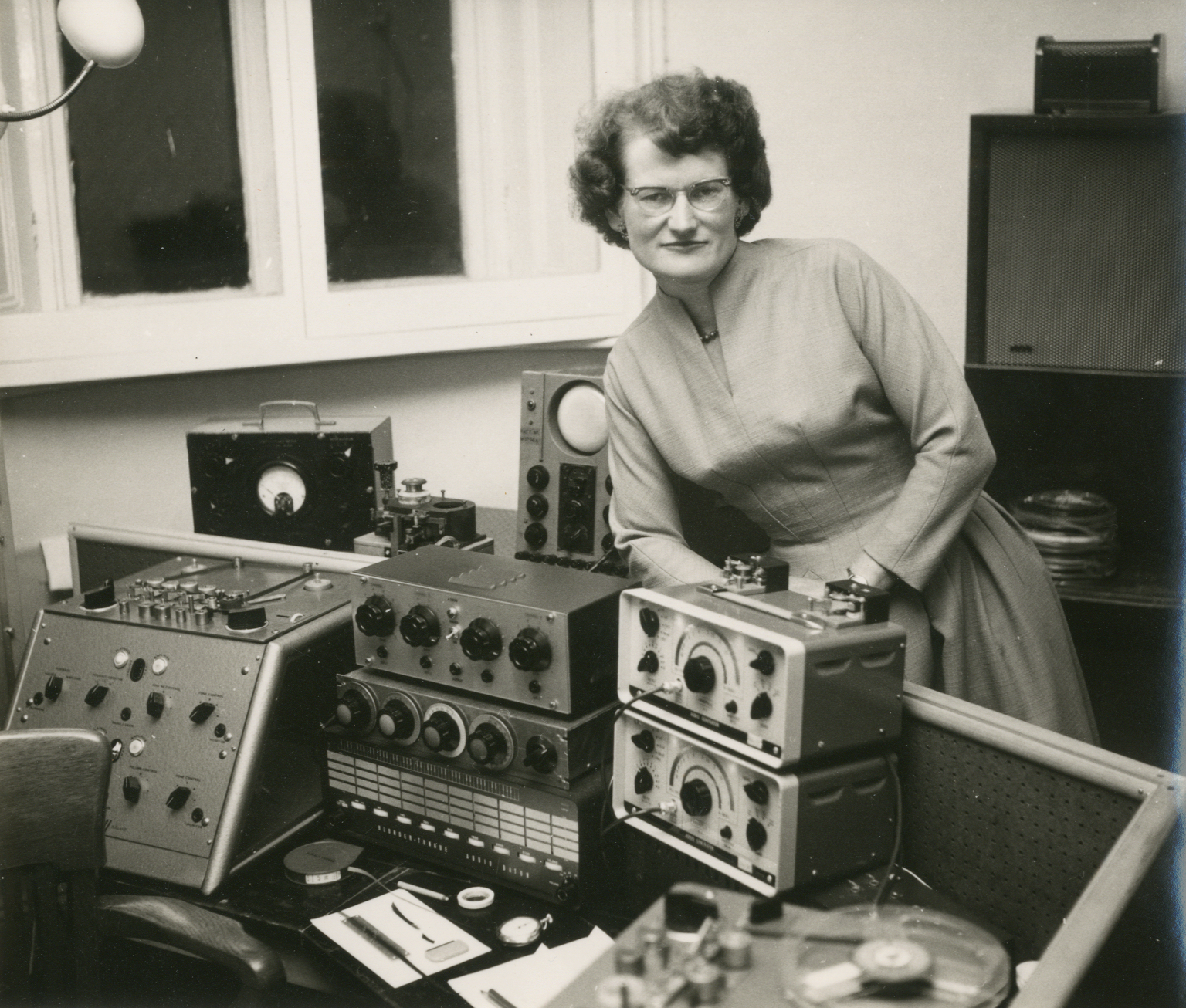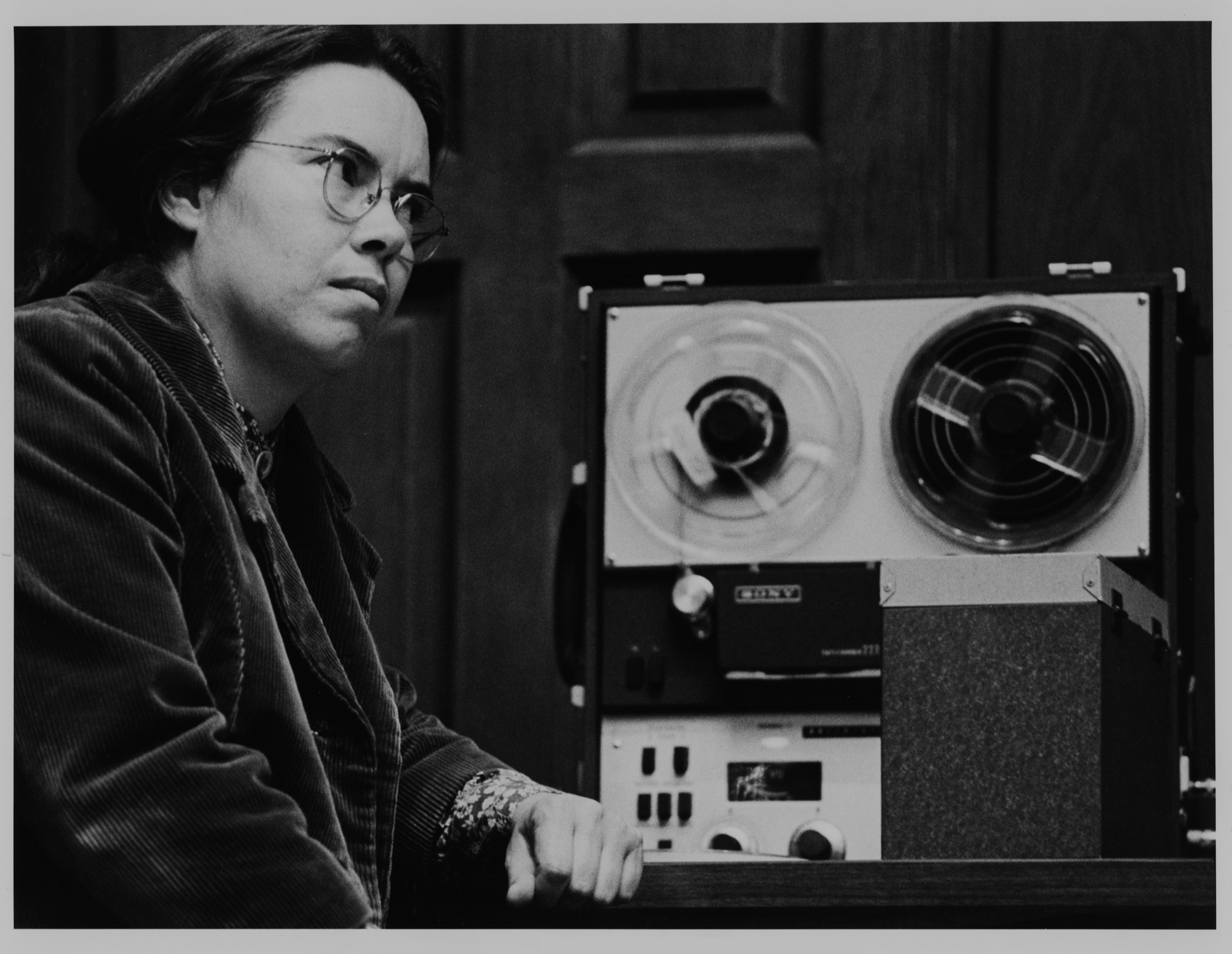Sisters with Transistors
20th May 2023, 5pm - 10pm
This is a FREE event funded by Cultivator, with limited spaces. Please book your tickets here
As part of the 2-part Wired event at CMR Project Space, our first event will be led by artist and director Alice Mahoney and artist, musician and founder of Cling Clack Studio, Stuart Blackmore. They will introduce the film Sisters with Transistors,
the untold story of electronic music’s female pioneers and remarkable composers who embraced machines and their liberating technologies to utterly transform how we produce and listen to music today.
This is our first in a series of regular screenings at CMR and welcomes everyone interested in obscure and experimental sound and music.
The evening will begin with a freshly prepared supper by artist and chef, Mollie Goldstrom, who creates interactive meals using ingredients locally sourced, grown or foraged. With an interest in the interpretive and exploratory possibilities of cookery, they have produced meals for audiences in a range of non-traditional settings, inviting collaboration and generosity through the preparation and sharing of food. Mollie will be providing food for our events and will be collaborating with artists working in CMR, riffing on themes for workshops and residencies.
Synopsis
Think of early electronic music and you’ll likely see men pushing buttons, knobs, and boundaries. While electronic music is often perceived as a boys club, the truth is from the very beginning women have been integral in inventing the devices, techniques and tropes that would define the shape of sound for years to come.
The history of women has been a history of silence. Recent protests calling for greater recognition of women’s achievements have swept across politics, business, even Hollywood. The world of music is no exception.
As one of the film’s subjects, Laurie Spiegel explains: “We women were especially drawn to electronic music when the possibility of a woman composing was in itself controversial. Electronics let us make music that could be heard by others without having to be taken seriously by the male dominated Establishment.”
With the wider social, political and cultural context of the 20th century as our backdrop, this all archival documentary reveals a unique emancipation struggle, restoring the central role of women in the history of music.
With Laurie Anderson as our narrator, we’ll embark on a fascinating journey through the evolution of electronic music. We’ll learn how new devices opened music to the entire field of sound, how electronic music not only changed the modes of production but in its wide-ranging effects also transformed the very terms of musical thought.
The story begins in 1929 New York with Clara Rockmore wowing classical music audiences by producing sounds from thin air with her theremin, a new electronic instrument. Clara’s worldwide performances helped to establish electronic and experimental music as a viable form in the public imagination. Cutting between never-before-seen black and white home movies of Clara in 1930s NY and images of Clara from the ’70s in her Upper West Side apartment, she reflects: “I had to make — and then meet — my own standards; I had to win the public over into thinking of the theremin as a real, artistic medium.”
With the wartime needs for improved means of communication came the invention of the magnetic tape recorder. It was suddenly possible to record and manipulate sounds in ways that were unimaginable before. Tape became more than just a means for recording and playing back music, it became an essential tool for composition. In 1950s Greenwich Village, we’ll discover how the first entirely electronic film score was composed by Bebe Barron and her husband Louis in 1956 for the MGM movie ‘Forbidden Planet’, made entirely from treated bleeps, blurps, whirs, whines, throbs, hums, and screeches generated by their own electronic circuits, recorded on tape. As Bebe recounts in a radio interview: “Vacuum tubes were our main components. There were also resistors, capacitors, inductors and semiconductors... We invented our own instruments since there weren’t any to buy.”
In post World War II Europe, where large numbers of women were recruited into jobs vacated by men who had gone to fight in the war, we’ll meet the first generation of women working in radio – Daphne Oram (UK), Eliane Radigue (FR), and Delia Derbyshire (UK) – whose unique experimentations with tape would later be felt in the early sound experiments of Les Paul, the studio manipulations of Beatles producer George Martin, the concrete pranks of Frank Zappa, the sampling and turntablism of hip-hop DJs from Grandmaster Flash to Q-Bert.
Outside the bounds of famous institutions like the BBC, iconoclastic composers were building their own instruments made from army surplus stores. We’ll meet one such composer, Pauline Oliveros, whose story will take us to San Francisco in the ’60s – the epicentre of experimental music “where synthesiser and tape loops met light shows and LSD”. But even in counter cultural environments like the San Francisco Tape Music Center, electronic music could be seen as a male pursuit. As Pauline remarks, “Men have a way of bonding around technology. There seemed to be an invisible barrier tied to a way of treating women as helpless or hapless beings.”
While some experimental artists were exploring the outer limits of sonic perception, others were bringing electronic music into the mainstream. In 1968, Wendy Carlos scored a hit record with ‘Switched-On Bach’, a collection of Bach pieces played on a Moog synthesiser, making Carlos a superstar and the synthesiser a thing of wonder. We’ll meet electronic wizard Suzanne Ciani as she recounts working with a Buchla synthesiser to compose scores for television commercials for corporations such as Atari and Coca-Cola as well as soundtracks for classic Hollywood films ‘The Incredible Shrinking Woman’ and ‘The Stepford Wives.’ In our interview with Suzanne she says “I couldn’t get a record deal, because the record companies were not interested in a woman who did not sing. Advertising wanted to be on the edge, they were looking for something different. I had total freedom. Nobody could tell me what to do, they didn’t know what I did.” We’ll conclude with Laurie Spiegel, whose prescient computer program Music Mouse from 1986, among the earliest music software available to regular consumers, underpins the practice of most of today’s bedroom producers. As she explains: “I got involved with computers in music out of frustration of other ways of doing music and also because of the incredible potential they had for combining the best of all worlds: the memory, the logic, and the complete freedom to define any kind of world you wanted.”
Near the end of the film, we meet the women in the present for the first time: new original footage of Suzanne, now 74, jamming on her Buchla in Bolinas, California, Laurie, now 75, on the streets of lower Manhattan feeding a kit of birds at dusk and Eliane, now 88, rehearsing with musicians in her Parisian apartment. Over new images of this first wave of pioneers, we’ll hear from the younger generation of contemporary female musicians, how finding out about these women impacted them, nurtured them. The film ends with a call to arms, to listen deeply, inclusively, and to continue to challenge the silence with beautiful noise. Birds in the sky, flying high.
Director’s note
SISTERS WITH TRANSISTORS is more than just the history of a music genre: it's the story of how we hear and the critical but little-known role female pioneers play in that story. Once I came to understand the integral part that women had played in forming the soundtrack to our lives - from the dings and chimes when we receive a text message to the music we dance, cry and sing to - I was compelled to break the silence that surrounded their stories.
And as easily as these stories have been forgotten, they all too easily could not have happened. As Laurie Spiegel says in our exclusive interview, “Composers were all white dead men. It was just not something I thought of as something I could ever do.” Classically there were no high-profile women composers. But with the discovery of electronic music, women no longer needed permission from their male counterparts to create – music now required just one person and a bunch of equipment, opening up a whole new avenue for female composers. Many embraced this opportunity from the outset to create a new genre of music that also gave rise to almost every sound you hear on a day to day basis.
The tools for making the first electronic music were the same as those found in physics labs and radar stations, hence it long being associated with masculine domains such as hard science and military technology. But, just as women were instrumental in early computer programming, telecommunications and broadcasting, there were also a number of innovative and ground-breaking female musicians who paved the way for modern music.
We know women and people of color have been silenced by hierarchies of privilege and oppression, but I’ve also come to believe that it’s the oversimplification of the way we tell stories, our learned longing for a (generally white male) hero that has led to the erasure of their groundbreaking accomplishments. That’s why I decided on a form featuring multiple heroines whose stories are told subjectively. As a way of confronting limiting storytelling practices, I opted for a chronology that weaves, a narration that’s not all-knowing.
In keeping with the vitality of the film’s subject, there won’t be any expert talking heads explaining the development of electronic music. Instead, the film fuses rarely seen and newly discovered moving images and stills culled from personal and public archives with multigenerational commentators in voiceover, present-day reflections of participants in that history and a younger generation who have been influenced by its legacy. The shortlist includes: Holly Herndon, Kim Gordon, Jean Michel Jarre, Nite Jewel, Morton Subotnik, Rhys Chatham.
The result is an oral history that moves, a series of personal recollections about the key moments in the history of electronic music merged with collective culture that unfolds like a mixtape where the voiceover functions like lyrics.
About the Filmmakers
Writer/Director
LISA ROVNER is an artist and filmmaker based in London. All of her creative projects, ranging from short films, music videos, adverts and art exhibitions are strung together by a fascination with archives and sound and her underlying aspiration to transform politics and philosophy into cinematographic spectacle. Rovner has collaborated with some of the most internationally respected artists and brands including Pierre Huyghe, Liam Gillick, Sebastien Tellier, Maison Martin Margiela and Acne. Her films have been presented internationally in art venues and theaters. Currently, she is in development on an episodic comedy about the art world and on a television series about revolutionary architecture. SISTERS WITH TRANSISTORS is her first feature documentary.
Producer
ANNA LENA VANEY (Anna Lena Films, France) is the producer of Zidane: A 21st Century Portrait which was a festival hit premiering in Cannes (Official Selection 2006), Sundance Film Festival and Toronto International Film Festival, while Punk premiered at the BFI London Film Festival (2012). Her company is dedicated to bold subjects and new formats produced in collaboration with esteemed international contemporary artists and authors. She is now developing feature length films by Philippe Parreno, Rirkrit Tiravanija, Jesper Just and Sophia Al- Maria.
Coproducer
MARCUS WERNER HED (Willow Glen Films) explores contemporary arts and culture, through documentary and fiction, and has several award-winning films under his belt, notably The R&B Feeling (2016 co-production with the BBC). Set for release this year is another co- production with BBC; Other, Like Me - The Story of Coum and Throbbing Gristle, and in pre-production is an adaption of Thomas Gonzales novel In The Beginning Was The Sea, a thriller set in 1970s Colombia.
Narrator
LAURIE ANDERSON is a highly acclaimed performance artist who also became an unlikely pop star in the 1980s. She was a pioneer of multimedia Performance and Installation art, before crossing over into the popular music industry with songs from her large-scale performance pieces, later producing full albums for commercial release. As one of the first artists of her downtown New York context to achieve a level of commercial fame, she was at the forefront of debates around the influence of mass media on the art world. She has since been recognized as being remarkably ahead of her time in embracing of new technologies in art and performance practice, and in her engagement with new media to share her work.
Editors
MICHAEL AAGLUND is an award-winning Copenhagen based Docutitles: The Distant Barking of Dogs (Dragon Award, Gothenburg 2018), Kingdom of Us (BAFTA Nominated, Outstanding Debut 2018), Concerning Violence (Official Selection, Sundance 2014), Forse In Peril (Camera d'Or Nominated, Cannes Critics Week 2013) and A World Not Ours (Peace Prize, Berlinale 2013). Seven times BAFTA Nominated, two times BAFTA Short film Winner Until The River Runs Red (2011) and ROOM8 (2014). His films have been in Official Selection at: Cannes, Berlin, Sundance, TIFF, Tribeca, CPH:DOX, IDFA, Locarno, Edinburgh, SXSW, HotDocs, Karlovy Vary & Yamagata
MARIKO MONTPETIT trained in Fine Arts at the Glasgow School of Arts, TAMK School of Art and Media, Finland, and Duncan of Jordanstone College of Art and Design, Dundee. She works as an editor on films and documentaries, and is involved in collaborations with artists and choreographers. In documentary, she has worked with filmmakers Joshua Oppenheimer on The Act of Killing and The Look of Silence, Marcus Werner Hed on The R&B Feeling, Simon Hipkins on Sisters of The Blood Feud and Inside The Cryptokingdom, Mani Benchelah on This Is Exile, and Chloë Mercier on Sex Needles & Roubles. She also worked with choreographers such as Russell Maliphant (London) and dance collective Loge 22 (Lyon), and artists Robin Meier, Maeve Brennan and The Otolith Group.
KARA BLAKE is a Canadian video artist and editor whose creative projects range from films and music videos to live performance visuals and installation pieces. Her work has been shown internationally at festivals and venues including the Museum of Modern Art New York, Centre Pompidou, Telluride Festival, and CPH:DOX. Blake’s multi-channel works include Lasciare Suonare (2019) for Place des Arts in Montréal and The Offerings (2017), part of the Musée d’art contemporain de Montréal’s touring exhibition Leonard Cohen : A Crack in Everything. In 2011, Blake was named national winner of the RBC Emerging Filmmaker Competition hosted by the Toronto International Film Festival and, in 2009, her film The Delian Mode, about the electronic music pioneer Delia Derbyshire won both the Genie Award and HotDocs Award for Best Short Documentary. Blake holds a Master’s of Fine Arts degree from Concordia University in Montréal where she continues to live and work.
Sound designer
MARTA SALOGNI is an Italian record producer, mixer and recording engineer. Salogni's musical background was cultivated in her native Italy between the small towns of Capriolo and Brescia, where she spent her formative years, collaborating with musical acts of all styles. As a producer and mixer, Marta Salogni has worked with Björk, M.I.A., Factory Floor, Kelela, Liars, Alex Cameron, Daniel Blumberg, Little Boots, Temples, Insecure Men, The Orielles, HMLTD, and Django Django.
Website: www.sisterswithtransistors.com
Instagram: @sisterswithtransistors
Duration: 84min



